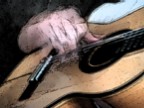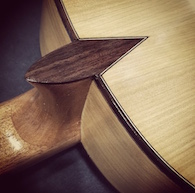Welcome to one of the most active flamenco sites on the Internet. Guests can read most posts but if you want to participate click here to register.
This site is dedicated to the memory of Paco de Lucía, Ron Mitchell, Guy Williams, Linda Elvira, Philip John Lee, Craig Eros, Ben Woods, David Serva and Tom Blackshear who went ahead of us.
We receive 12,200 visitors a month from 200 countries and 1.7 million page impressions a year. To advertise on this site please contact us.
|

|
|
Bridges and compensation for bases??
|
You are logged in as Guest
|
|
Users viewing this topic: none
|
|
Login  | |
|

   
Ramón
Posts: 440
Joined: Feb. 23 2005
From: La Jolla, Ca

|
 Bridges and compensation for bases?? Bridges and compensation for bases??
|
|
|
I just had an interesting talk with my neighbor, classical guitarist Randy Pile. I was looking at his newer Little Pepe Romero brazilian classical, his 65' Rodriguez classical, and another builder's classical... We started talking about bridges, and Yuris Zeltzin had explained to him that bridges should be compensated for the thickness of the base strings, and the bridge is therefore NOT square from the top's glueup line, but set long for the bases - or set square, and the bridge-slot is cut at an angle to give more length on the bases...
Okay. This one is new to me......... I see Blackshear's plans and he talks about a "2mm comensation at the nut", but I assumed it was overall, but perhaps it wasn't clarified? Was he compensating at the nut and not the bridge?
The Romero is straight, no compensation; 655 across. The Rodriguez HAS 2mm compensation for the bases (657 base E, 655 treble E), and the other's was actually 1mm longer on the trebles (mistake? Newer builder... Don't know..)
I'd assumed Blackshear's "2mm compensation" was overall, but was I mistaken?
What are you guys doing? Tom, Anders, Pers, etc..?
|
|
|
|
REPORT THIS POST AS INAPPROPRIATE |
Date Mar. 13 2008 4:33:54
 |
|

   
Ramón
Posts: 440
Joined: Feb. 23 2005
From: La Jolla, Ca

|
 RE: Bridges and compensation for bases?? (in reply to Ramón) RE: Bridges and compensation for bases?? (in reply to Ramón)
|
|
|
Hey Tom,
Yea, you helped me with my first 'mistake' in that I ended up setting the bridge back - evenly - 2mm, as we had discussed on the phone, but then this discussion had come up, and I'd never heard about the comensation of JUST the bases, so I thought I'd post. (I don't have my Reyes plans in front of me, they're at the shop with 2 new guitars (in stages) on top of them....)
So I was curious and posted, as I'd never heard of this... And like I said, the Rodriguez IS compensated. I'll have to get a square and figure out what Miguel did to get this, but there IS 2mm more on those bases...
|
|
|
|
REPORT THIS POST AS INAPPROPRIATE |
Date Mar. 13 2008 5:53:53
 |
|

   
Ramón
Posts: 440
Joined: Feb. 23 2005
From: La Jolla, Ca

|
 RE: Bridges and compensation for bases?? (in reply to Ramón) RE: Bridges and compensation for bases?? (in reply to Ramón)
|
|
|
Interesting... I have truly never seen, heard, nor noticed this on a guitar. Yes, steel string acoustic, and I've seen some ideas about super-adjustable bridges, where every string had it's own saddle that could be individually adjusted...
Hmmmm....Looking at your website pics, Anders. Looks like the Conde-ish orange finish is noticeably compensated in the bone-slot, yes?
I'm kind of blown away... I've never seen nor read this on plans - nor in guitar making books. I set my saddle back 2mm overall- even, and the tone is outstanding - or so I'm told. What would change with only the bases compensated??
Which begs a question; Why don't we make 2, ½-length slots? 1 side for base, set slightly back, like this. Would this be easier? Or just something that 'breaks tradition' and would not be accepted?
Or does the slight taper account for the string's diameters more evenly??
Just curious....
Anders; have you ever NOT compensated so, and what were the results?
Thanks all!

Images are resized automatically to a maximum width of 800px
 Attachment (1) Attachment (1)
|
|
|
|
REPORT THIS POST AS INAPPROPRIATE |
Date Mar. 13 2008 12:21:36
 |
|
 New Messages New Messages |
 No New Messages No New Messages |
 Hot Topic w/ New Messages Hot Topic w/ New Messages |
 Hot Topic w/o New Messages Hot Topic w/o New Messages |
 Locked w/ New Messages Locked w/ New Messages |
 Locked w/o New Messages Locked w/o New Messages |
|
 Post New Thread
Post New Thread
 Reply to Message
Reply to Message
 Post New Poll
Post New Poll
 Submit Vote
Submit Vote
 Delete My Own Post
Delete My Own Post
 Delete My Own Thread
Delete My Own Thread
 Rate Posts
Rate Posts
|
|
|
Forum Software powered by ASP Playground Advanced Edition 2.0.5
Copyright © 2000 - 2003 ASPPlayground.NET |
0.0625 secs.
|


 Printable Version
Printable Version












 New Messages
New Messages No New Messages
No New Messages Hot Topic w/ New Messages
Hot Topic w/ New Messages Hot Topic w/o New Messages
Hot Topic w/o New Messages Locked w/ New Messages
Locked w/ New Messages Locked w/o New Messages
Locked w/o New Messages Post New Thread
Post New Thread